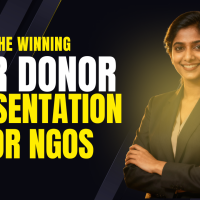This is a very important question because a project proposal is a lengthy document comprising of several different components. There is an introduction part, a background story, an explanation to justify the project, there are of course goals, objectives and strategies. But what is that single page in the proposal to which every donor would turn and look into before giving a final decision.

For every donor, it is important that there is ‘transparency’ in the process of developing and implementing a project. Transparency is about involving stakeholders, sharing ideas and building the project with every real activity connected to your goal and objectives.
‘Impact’ is necessary because of which most proposals seek enormous information about the expected results. In fact, big donor agencies dedicated several pages of their proposal format documents on ‘results analysis’ to identify and understand that every penny spent will generate some impact at the ground-level. Further, the monitoring and evaluation process defined inside a proposal determines the ability of the agency to assess the impact the project will create in the long-run.
‘Capacity’ is also another important component of a project proposal. Donor agencies are interested to know how the organization proposing to implement a project is positioned with its skills and capacity. For example, if your organization has proposed to implement a project on ‘human rights empowerment’, the donor agency is going to assess if it has got some previous experience in human rights and at what level. Similarly, any women-empowerment projects require the proposing NGO to justify that it has got the right skills to execute such a project. Capacity also includes the number of experts you have in your organization on the subject. In some proposals, they also request information about your staff so that the donors are convinced that the project execution is in the right hands.
Donor agencies while reviewing project proposals are often under the habit of comparing project proposals. In highly competitive bids, this is very much prevalent. How other organizations have framed their project activities and strategies to achieve the desired goals and what type of resources they are using.
But the one last thing that influences most donors is what type of ‘budget’ the NGO is proposing inside the proposal. It is not rare that some donors will read your proposals backwards to make sure that the proposed budget is well within the reasonable expectations. If the budget is too high (or even to small), the donor will not take interest in reading the rest of the document.
When you are developing a project proposal, you need to check the application guidelines to find out if a budget limit has been mentioned. If it is not mentioned, then it is an essential part of your activity to collect intelligence about it. You can call the donor agency or research past projects to find out what is the budget limit. Once you know what the budget limit, it is a great eye-opener for you to develop the project.
Next>>>
Related:
- A Simple Step-by-Step Guide for NGOs on “How to write Proposals”
- Top 25 Tips on How to Write Proposals Effectively for Funding Success
- How to Write a Master Proposal Template









































